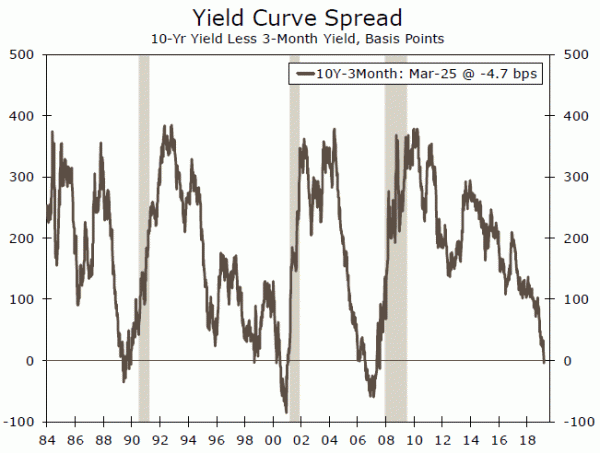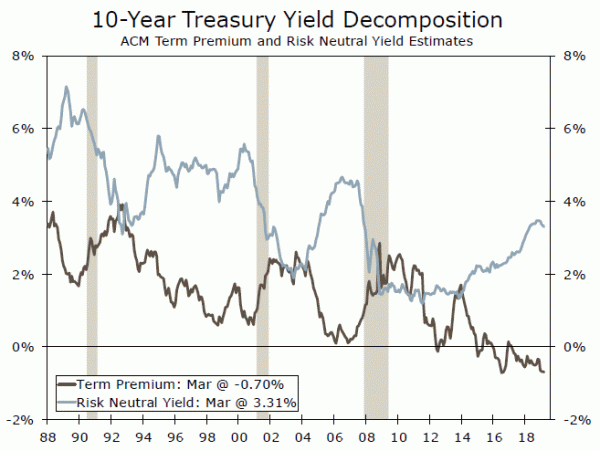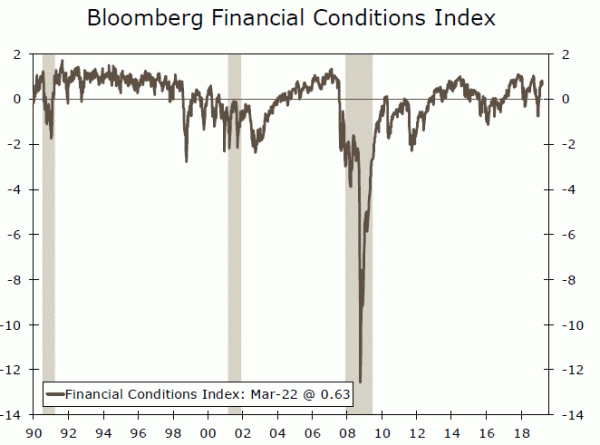The recent inversion of the yield curve is not very significant in a historical context, and previous Fed purchases of Treasury securities for its QE program means that the curve is probably flatter than it otherwise would be.
How Inverted Does the Yield Curve Need To Be?
The financial press has been filled with stories in recent days about the inversion of the yield curve, which historically has been a reliable predictor of recession. Indeed, the yield on the 10-year U.S. Treasury security moved below the yield on the 3-month T-bill on March 22, and the spread stood at -5 bps on March 25. Is a recession around the corner?
Let’s start by putting the recent inversion of the yield curve into perspective. As shown in the top chart, the curve inverted in July 2006, 17 months before the start of the Great Recession. The spread of the 10-year note over the 3-month bill fell to as much as -60 bps in early 2007. During the previous cycle, the curve inverted 8 months before the start of the recession in March 2001, and the yield spread fell to nearly -100 bps in late 2000. In other words, the degree of yield curve inversion at present is insignificant relative to previous cycles. The curve would probably need to invert significantly and remain inverted for weeks, if not months, before it would be a reliable recession signal.
Even so, there is some question about the reliability of the yield curve as a recession predictor at present. The purchase of Treasury securities by the Federal Reserve as part of its quantitative easing (QE) program collapsed the term premium on longer-dated Treasury bonds (middle chart). Researchers at the Fed estimate that the $1.5 trillion of QE purchases of Treasury securities reduced the term premium about 60 bps.1 The Fed has subsequently allowed about $300 billion of Treasury securities to roll off its balance sheet, but the yield on the 10-year Treasury security today is still arguably lower than it otherwise would be. In the absence of QE purchases, there probably would be a positive slope between the 3-month bill and the 10-year note at present.
Furthermore, the yield curve is really the only indicator that is signaling any sense of trouble at present. As shown by an index that is compiled by Bloomberg, financial conditions are not all that restrictive at present (bottom chart). The stock market generally remains supported, credit spreads generally remain tight and growth in bank lending remains positive. The financial crisis of a decade ago was obviously an extreme period, but overall financial conditions are less restrictive today than they were last December or around the time of the Russian debt default in 1998 or in the months leading up to the 2001 recession.
The recent inversion of the yield curve is interesting but, in our view, it does not necessarily signal that recession is around the corner. We would need to see a further sustained inversion of the curve along with generalized restriction in financial conditions in conjunction with deterioration in economic fundamentals before we would become truly worried. Stay tuned.
















